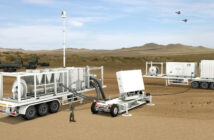– By John Knowles –
Our cover story in the October 2020 issue of JED, written by Andrew White, takes a look at Counter-UAS (C-UAS) developments in Europe. Considering the number of C-UAS systems available today, it’s surprising to remember that the C-UAS market is just a little over five years old. The first systems to be offered were merely adaptations of vehicle-based counter-RCIED jammers. These RCIED jammers were relatively inexpensive, they already covered the frequencies used by most commercial drones, and they were already in production. Today, there are hundreds of C-UAS solutions offered around the world, and they vary in size, operational range and sophistication. So far, this has been an incredibly rapid evolution for such a young market.
In July 2019, the USS Boxer was operating in the Persian Gulf. An Iranian UAS managed to fly within 1,000 yards of the LHD before it was downed with RF jamming from a Light Marine Air Defense Integrated System (LMADIS) C-UAS system onboard the Boxer. How did the US Navy manage to “integrate” a C-UAS capability onto the Boxer? The LMADIS was housed on a two-seat MRZR all-terrain vehicle that was parked (with aircraft chocks under the wheels) at the end of the Boxer’s 843-foot flight deck. This was a quick and clever solution for providing a much needed C-UAS solution for the ship. Yet it also illustrates how far we are from truly integrating a wide range of mature C-UAS solutions onto large, complex weapons systems.
In October 2017, less than two years before the LMADIS downed the Iranian drone, ISIS released video footage that showed one of its quadcopter drones dropping two incendiary munitions on a Syrian government weapons depot housed in a sports stadium near Mayadeen in the eastern part of the country. The ammunition burned and exploded for hours. It was one of many drone attacks ISIS has documented in Syria and Northern Iraq beginning in 2016.
These two examples illustrate the diverse nature of the C-UAS challenge. Today, one segment of the C-UAS market is focused on integrating this capability into larger air defense systems. This enables utilization of more advanced sensors and targeting capabilities than a typical stand-alone C-UAS system would have. These solutions are also bringing more non-kinetic technologies, such as high-power microwaves and high-energy lasers, into the C-UAS countermeasures suite. At the other end of the spectrum are small “wearable” C-UAS solutions featuring RF jammers, which are suited for special operations forces and similar applications where a small size, weight and power (SWAP) footprint is essential.
As the C-UAS market matures, some applications will eventually see electronic attack solutions technoligically converge with other RF systems, such as radios. Other C-UAS capabilities, particularly at the low-end, may remain discrete solutions because they are so small and inexpensive. These types of trends have happened with RCIED jammers, and I expect the same will hold true with C-UAS. In the meantime, the good news for military forces is that the C-UAS market will likely remain very dynamic with many new types of solutions being offered for many years. ♦
If you enjoyed this article, please share. If you would like to read more articles like this one, we encourage you to join the AOC to receive a copy of JED every month.





